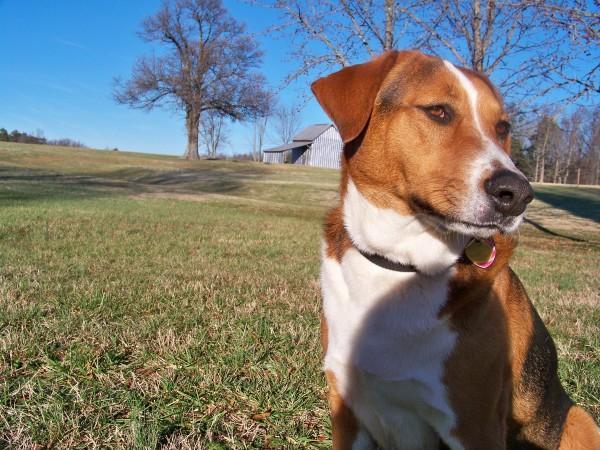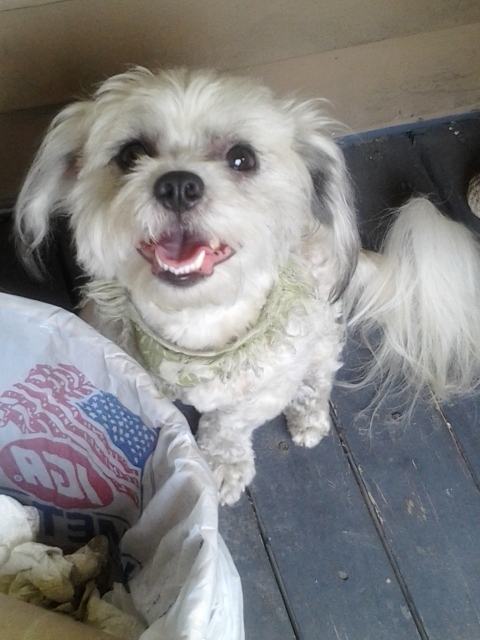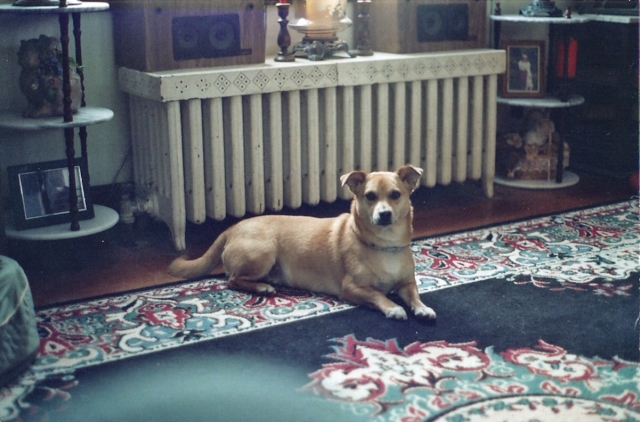QuestionYes have had dogs many years getting a 17 week old 40# Doberman puppy already have a 13 year old Papillon 7#4 oz. & a 8 month old Long Haired Minnie Doxie any ideas on how to teach the Dobe Pup to be careful around the little girls??? The girls are spayed and the Dobe will be neuterd as soon as he can be.Getting the Dobe pup soon can i take him to a Pets Mart puppy class on the 18th of this month???
Thanks for any ideas.
AnswerHi Bernadee,
Thank you for writing to me. I can see that you truly love dogs and what a nice furry family you have!
I am sorry for the delay in getting back to you. I have been having on-going computer problems. Thank you for your patience.
The most important thing you can do with your Dobbie puppy is to crate train him as soon as he arrives home.
Dogs that are under a year or even older need to be crate trained for their own protection and the peace of mind of their guardians.
Providing your puppy or dog with an indoor kennel crate can satisfy many dogs' need for a den-like enclosure. Besides being an effective housebreaking tool (because it takes advantage of the dog's natural reluctance to soil its sleeping place), it can also help to reduce separation anxiety, to prevent destructive behavior (such as chewing furniture), to keep a puppy away from potentially dangerous household items (i.e., poisons, electrical wires, etc.), and to serve as a mobile indoor dog house which can be moved from room to room whenever necessary.
A kennel crate also serves as a travel cabin for you dog when travelling by car or plane. Additionally, most hotels which accept dogs on their premises require them to be crated while in the room to prevent damage to hotel furniture and rugs.
Most dogs which have been introduced to the kennel crate while still young grow up to prefer their crate to rest in or "hang-out" in. Therefore a crate (or any other area of confinement) should NEVER be used for the purpose of punishment.
We recommend that you provide a kennel crate throughout your dog's lifetime. Some crates allow for the removal of the door once it is no longer necessary for the purpose of training. The crate can be placed under a table, or a table top can be put on top of it to make it both unobtrusive and useful.
Vari-Kennel type: Take the crate apart, removing the screws, the top and the door. Allow your pup to go in and out of the bottom half of the crate before attaching the top half. This stage can require anywhere from several hours to a few days. This step can be omitted in the case of a young puppy who accepts crating right away.
Wire Mesh type:Tie the crate door back so that it stays open without moving or shutting closed. If the crate comes with a floor pan, place a piece of cardboard or a towel between the floor (or crate bottom) and the floor pan in order to keep it from rattling.
Toys and Treats: Place your puppy's favorite toys and dog treats at the far end opposite the door opening. These toys may include the "Tuffy", "Billy", "Kong", "Nylabone" or a ball. Toys and bails should always be inedible and large enough to prevent their being swallowed. Any fragmented toys should be removed to prevent choking and internal obstruction. You may also place a sterilized marrow bone filled with cheese or dog treats in the crate.
Water: A small hamster-type water dispenser with ice water should be attached to the crate if your puppy is to be confined for more than two hours in the crate.
Bedding: Place a towel or blanket inside the crate to create a soft, comfortable bed for the puppy. If the puppy chews the towel, remove it to prevent the pup from swallowing or choking on the pieces. Although most puppies prefer lying on soft bedding, some may prefer to rest on a hard, flat surface, and may push the towel to one end of the crate to avoid it. If the puppy urinates on the towel, remove bedding until the pup no longer eliminates in the crate.
Whenever possible, place the crate near or next to you when you are home. This will encourage the pup to go inside it without his feeling lonely or isolated when you go out. A central room in the apartment (i.e.: living room or kitchen) or a large hallway near the entrance is a good place to crate your puppy.
In order that your puppy associate the kennel crate with comfort, security and enjoyment, please follow these guidelines:
Occasionally throughout the day, drop small pieces of kibble or dog biscuits in the crate. While investigating his new crate, the pup will discover edible treasures, thereby reinforcing his positive associations with the crate. You may also feed him in the crate to create the same effect. If the dog hesitates, it often works to feed him in front of the crate, then right inside the doorway and then, finally, in the back of the crate.
In the beginning, praise and pet your pup when he enters. Do not try to push, pull or force the puppy into the crate. At this early stage of introduction only inducive methods are suggested. Overnight exception: You may need to place your pup in his crate and shut the door upon retiring. (In most cases, the crate should be placed next to your bed overnight. If this is not possible, the crate can be placed in the kitchen, bathroom or living room.)
You may also play this enjoyable and educational game with your pup or dog: without alerting your puppy, drop a small dog biscuit into the crate. Then call your puppy and say to him, "Where's the biscuit? It's in your room." Using only a friendly, encouraging voice, direct your pup toward his crate. When the puppy discovers the treat, give enthusiastic praise. The biscuit will automatically serve as a primary reward. Your pup should be free to leave its crate at all times during this game. Later on, your puppy's toy or ball can be substituted for the treat.
It is advisable first to crate your pup for short periods of time while you are home with him. In fact, crate training is best accomplished while you are in the room with your dog. Getting him used to your absence from the room in which he is crated is a good first step. This prevents an association being made with the crate and your leaving him/her alone.
Collars: Always remove your puppy or dog's collar before confining in the crate. Even flat buckle collars can occasionally get struck on the bars or wire mesh of a crate. If you must leave a collar on the pup when you crate him (e.g.: for his identification tag), use a safety "break away" collar.
Warm Weather: Do not crate a puppy or dog when temperatures reach an uncomfortable level. This is especially true for the short-muzzled (Pugs, Pekes, Bulldogs, etc.) and the Arctic or thick- coated breeds (Malamutes, Huskies, Akitas, Newfoundlands, etc.). Cold water should always be available to puppies, especially during warm weather. [Never leave an unsupervised dog on a terrace, roof or inside a car during warm weather. Also, keep outdoor exercise periods brief until the hot weather subsides.]
Be certain that your puppy has fully eliminated shortly before being crated. Be sure that the crate you are using is not too large to discourage your pup from eliminating in it. Rarely does a pup or dog eliminate in the crate if it is properly sized and the dog is an appropriate age to be crated a given amount of time.
Crating Duration Guidelines
9-10 Weeks
Approx. 30-60 minutes
11-14 Weeks
Approx. 1-3 hours
15-16 Weeks
Approx. 3-4 hours
17 + Weeks
Approx. 4+ (6 hours maximum)
*NOTE: Except for overnight, neither puppies nor dogs should be crated for more than 5 hours at a time. (6 hours maximum!)
NEVER use the crate as a form of punishment or reprimand for your puppy or dog. This simply causes the dog to fear and resent the crate. If correctly introduced to his crate, your puppy should be happy to go into his crate at any time. You may however use the crate as a brief time-out for your puppy as a way of discouraging nipping or excessive rowdiness.
[NOTE: Sufficient daily exercize is important for healthy puppies and dogs. Regular daily walks should be offered as soon as a puppy is fully immunized. Backyard exercize is not enough!]
Do not allow children to play in your dog's crate or to handle your dog while he/she is in the crate. The crate is your dog's private sanctuary. His/her rights to privacy should always be respected.
In most cases a pup who cries incessantly in his crate has either been crated too soon (without taking the proper steps as outlined above) or is suffering from separation anxiety and is anxious about being left alone. Some pups may simply under exercised. Others may not have enough attention paid them. Some breeds of dog may be particularly vocal (e.g., Miniature Pinchers, Mini Schnauzers, and other frisky terrier types). These dogs may need the "Alternate Method of Confining Your Dog", along with increasing the amount of exercise and play your dog receives daily.
When Not To Use A Crate
Do not crate your puppy or dog if:
It is too young to have sufficient bladder or sphincter control.
It has diarrhea. Diarrhea can be caused by: worms, illness, intestinal upsets such as colitis, too much and/or the wrong kinds of food, quick changes in the dogs diet, or stress, fear or anxiety.
It is vomiting.
You must leave it crated for more than the Crating Duration Guidelines suggest.
It has not eliminated shortly before being placed inside the crate.
The temperature is excessively high.
It has not had sufficient exercise, companionship and socialization.
Buying a Crate
Where to buy a crate: Crates can be purchased through most pet supply outlets, through pet mail order catalogs and through most professional breeders. Some examples are:
Crate Size and Manufacturers:
Dog Size:
Small: (Vari-Kennel #100 or General Cage #201)
Toy Poodles, the Maltese, etc., with average weight of 6-10 lbs.
Medium Small: (Vari-Kennel #200 or General Cage #202/212)
Mini Schnauzers, Jack Russells, etc., with average weight of 11-20 lbs.
Medium: (Vari-Kennel #300 or General Cage #203/213)
Cocker Spaniels, Field Spaniels, small Shelties, etc., with average weight of 21-40 lbs.
Large: (Vari-Kennel #400 or General Cage #204/214)
Huskies, large Samoyeds, small Golden Retrievers, etc., with average weight of 41-65 Ibs.
Very Large: (Vari-Kennel #500 or General Cage #205/215)
German Shepherds, Alaskan Malamutes, Rottweilers, etc., with average weight of 67-100 lbs.
Extra Large: (General Cage #206 or Mid-West #89-Z, 89-E or 99)
Newfoundlands, Great Danes, etc, with average weight of 110 lbs. plus.
The Cost of A Crate
Crates can cost between $35 and $150 depending on the size and the type of crate and the source.
The Cost of Not Buying a Crate
The cost of not using a crate:
your shoes
books
table legs
chairs and sofas
throw rugs and carpet
electric, telephone and computer wires.
The real cost, however, is your dog's safety and your peace of mind.
Alternative Method Of Confining Your Puppy
There are alternative methods to crating very young puppies and puppies who must be left alone in the house for lengths of time exceeding the recommended maximum duration of confinement.
Use a small to medium-sized room space such as a kitchen, large bathroom or hallway with non- porous floor. Set up the crate on one end, the food and water a few feet away, and some newspaper (approx. 2'x3' to 3'x3') using a 3 to 4 layer thickness, several feet away. Confine your puppy to this room or area using a 3 ft. high, safety-approved child's gate rather than shutting off the opening by a solid door. Your pup will feel less isolated if it can see out beyond its immediate place of confinement. Puppy proof the area by removing any dangerous objects or substances.
Your puppy should be monitored at all times when out of the crate in order to protect your other dogs. Both dogs, as you have described are very delicate. Older dogs want no part of puppies and Doxies have fragile spines.
Be sure to give your Dobbie a tremendous amount of exercise that that he doesn't have a need to rough house with the other two dogs.
Praise him for being gentle and show him what you expect of him. It is vital that you establish yourself as the alpha leader of the pack. In this way your dog will respect and listen to you.
You may have to create areas that are off limit to your Dobbie, where the other two can have freedome without fear. A great way to do this is to purchase x-pens (J&B Wholesale Pet Supply - do a Google for the website). Be sure that you purchase one that is tall enough to prevent your Doggie from jumping over it.
Just as small children should never be left alone with a dog, no matter how trustworthy the dog might be, the same is true for your other two dogs and your Dobbie. I would allow them to become friends but never assume anything and for their safety,be sure that you are in control of the situation at all times.
Best of Luck,
Shelley Davis

 My 1 year old Yorktese is paper trained but goes pee in the middle of the kitchen floor
Question
QUESTION: I have a wonderful 1 year old
My 1 year old Yorktese is paper trained but goes pee in the middle of the kitchen floor
Question
QUESTION: I have a wonderful 1 year old
 Chewing and ripping apart
Questionbut... im a full time student..... walk her dai
Chewing and ripping apart
Questionbut... im a full time student..... walk her dai
 My dogs agression
Question
This is my dog
Hi Shelley!
I have a question f
My dogs agression
Question
This is my dog
Hi Shelley!
I have a question f
 My shitzu/bision (is on facebook)
Question
Barkley
Barkley Layberger ,my dear 2 ye
My shitzu/bision (is on facebook)
Question
Barkley
Barkley Layberger ,my dear 2 ye
 mixed breed dog
QuestionSweetie Monster
QUESTION: hi this may be
mixed breed dog
QuestionSweetie Monster
QUESTION: hi this may be